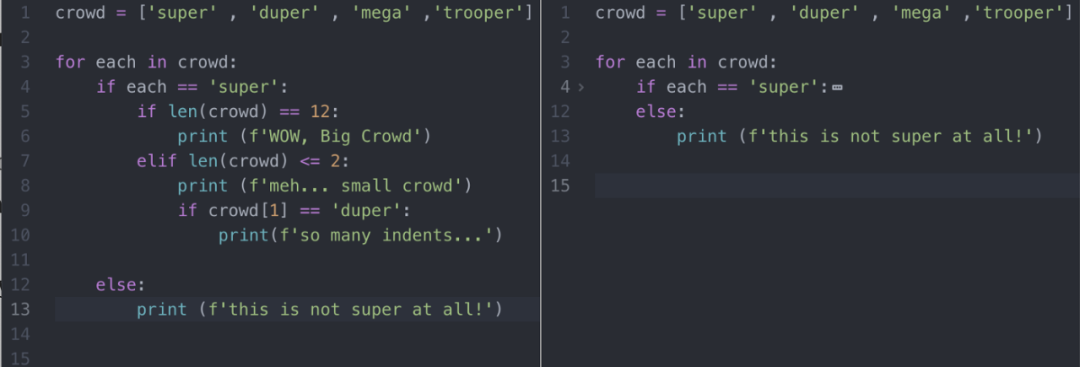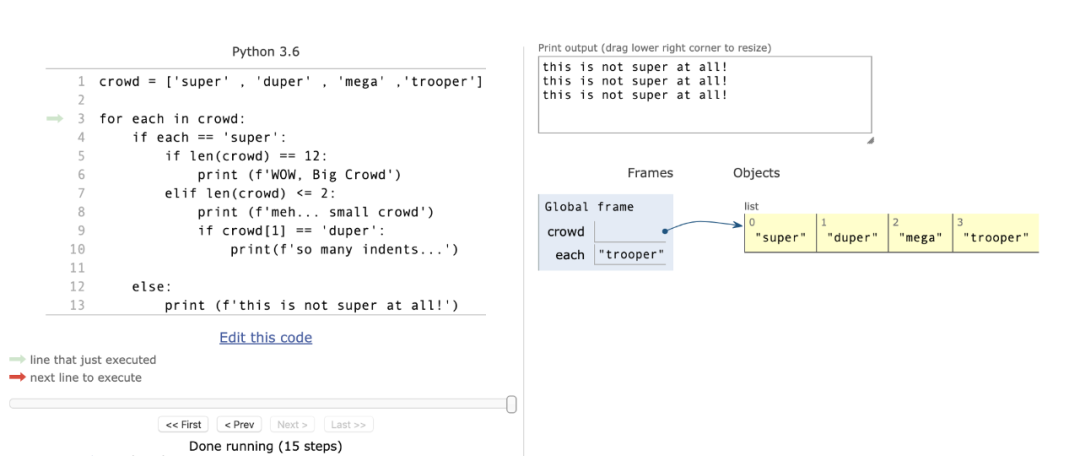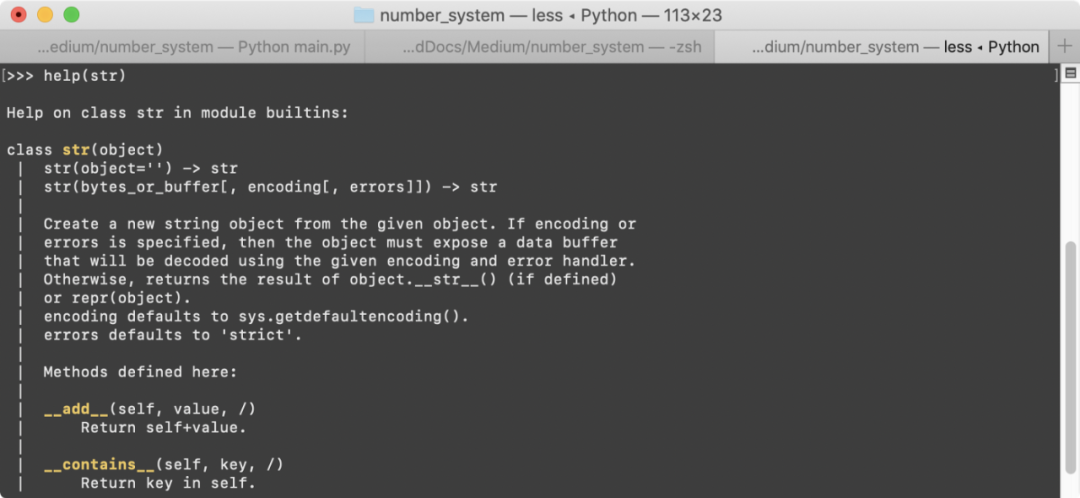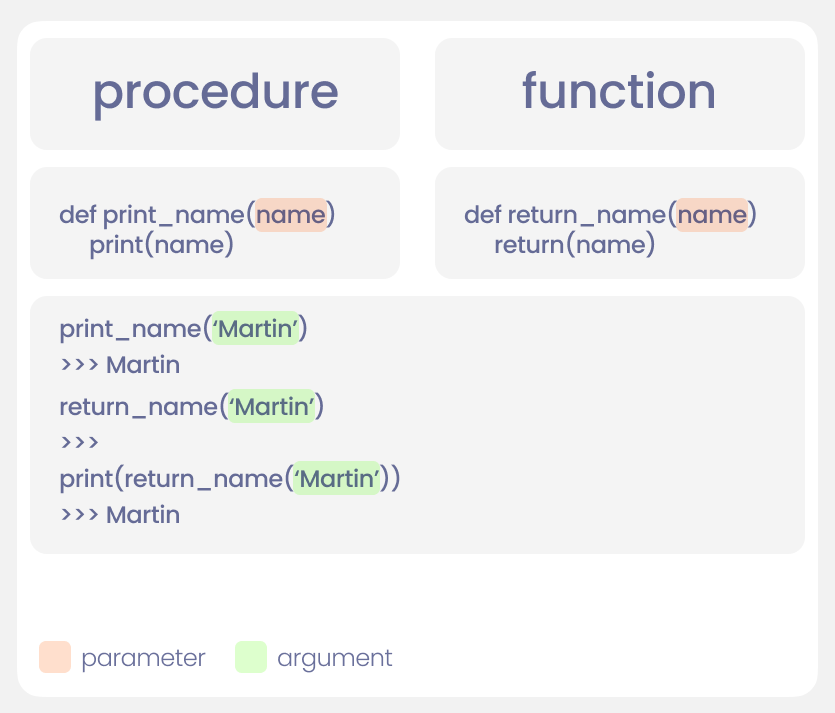Python大佬 | 菜鸟进阶必备的九大技能!

初学者与中级程序员
初学者与中级程序员
解决问题和提出问题; XY问题; 理解代码为何起作用(或不起作用); 使用字符串; 使用列表; 使用循环; 使用函数(并正确谈论函数); 面向对象编程; 尊重PEP。
解决问题和提出问题
解决问题和提出问题
How to Ask Questions About Programming:https://medium.com/better-programming/how-to-ask-questions-about-programming-dcd948fcd2bd
XY问题
XY问题
“我需要从字符串中提取最后3个字符。” “不,你不需要。只需文件扩展名。”
def extract_ext(filename):return filename[-3:]print (extract_ext('photo_of_sasquatch.png'))>>> png
def extract_ext(filename):return filename.split('.')[-1]print (extract_ext('photo_of_sasquatch.png'))print (extract_ext('photo_of_lochness.jpeg'))>>> png>>> jpeg
https://www.geeksforgeeks.org/python-os-path-splitext-method/
理解代码为何起作用(或不起作用)
理解代码为何起作用(或不起作用)

右侧是折叠了if/else语句的ATOM

使用字符串
使用字符串
word = 'supergreat'print (f'{word[0]}')>>> sprint (f'{word[0:5]}')>>> super


filenames = ['lochness.png' , 'e.t.jpeg' , 'conspiracy_theories_CONFIRMED.zip']# 1: Using ENDSWITHfor files in filenames:if files.endswith('zip'):print(f'{files} is a zip file')else:print (f'{files} is NOT a zip file')# 2: Using SPLITfor files in filenames:if files.split('.')[-1] == 'zip':print(f'{files} is a zip file (using split)')else:print (f'{files} is NOT a zip file (using split)')
使用列表
使用列表
my_list = ['a' , 'b' , 'n' , 'x' , 1 , 2 , 3, 'a' , 'n' , 'b']for item in my_list:print (f'current item: {item}, Type: {type(item)}')

print (my_list.sort())

如果我们想把整数与字母分开要怎么做?一种方式是通过循环来实现,我们可以遍历列表中的所有项目。初学者很早就会使用循环了,循环对于编程也很重要。 代码可能是下面这样的: my_list = ['a' , 'b' , 'n' , 'x' , 1 , 2 , 3 , 'a' , 33.3 , 'n' , 'b']number_list = []string_list = []for item in my_list:print (f'current item: {item}, Type: {type(item)}')if not isinstance(item,str):number_list.append(item)else:string_list.append(item)my_list = string_list即便有些混乱,这也是一种有效的方式,可以运行,不过经过重构可以用单行来表示! 如果想要生活多些乐趣,请学习Python的列表解析式下面是同样问题通过列表解析式得出的: my_list = [letter for letter in my_list if isinstance(letter,str)]就是这样! 还没结束!使用过滤器也可以获得同样的结果: def get_numbers(input_char):if not isinstance(input_char,str):return Truereturn Falsemy_list = [1,2,3,'a','b','c']check_list = filter(get_numbers, my_list)for items in check_list:print(items)
额外知识点
额外知识点
反向列表(或字符串):
names = ['First' , 'Middle' , 'Last']print(names[::-1])>>> ['Last', 'Middle', 'First']
在列表中加入元素:
names = ['First' , 'Middle' , 'Last']full_name = ' '.join(names)print(f'Full Name:\n{full_name}')>>> First Middle Last6. 使用循环:
greek_gods = ['Zeus' , 'Hera' , 'Poseidon' , 'Apollo' , 'Bob']for index in range(0,len(greek_gods)):print (f'at index {index} , we have : {greek_gods[index]}')
for name in greek_gods:print (f'Greek God: {name}')
for index, name in enumerate(greek_gods):print (f'at index {index} , we have : {name}')

使用函数(并正确谈论函数)
使用函数(并正确谈论函数)

def print_list(input_list):for each in input_list:print(f'{each}')print() #just to separate outputgreek_gods = ['Zeus' , 'Hera' , 'Poseidon' , 'Apollo' , 'Bob']grocery_list = ['Apples' , 'Milk' , 'Bread']print_list(greek_gods)print_list(grocery_list)print_list(['a' , 'b' , 'c'])

def reverse_list(list_input):return list_input[::-1]my_list = ['a', 'b' , 'c']print (reverse_list(my_list))>>> ['c', 'b', 'a']
面向对象编程
面向对象编程
class Student():def __init__(self,name):self._name = nameself._subject_list = []
如果想要创建一个student,可以像这样将其分配给变量:student1 = Student('Martin Aaberge')如果需要更多student,可以使用同一个类并添加另外的姓名:student2 = Student('Ninja Henderson')`student1`和`student2`都是student类的实例,它们共享同一个蓝图,但彼此之间并无关系。此时,我们对学生们能做的不多,但我们确实增加了一个主题列表。要填充此列表,我们需要创建方法,你可以调用方法来实现与该类实例的交互。我们更新:class Student():def __init__(self,name):self._name = nameself._subject_list = []def add_subject(self, subject_name):self._subject_list.append(subject_name)def get_student_data(self):print (f'Student: {self._name} is assigned to:')for subject in self._subject_list:print (f'{subject}')print()这个类可以用于创建、编辑学生信息,并获取我们存在其中的信息:#create students:student1 = Student('Martin Aaberge')student2 = Student('Heidi Hummelvold')#add subjects to student1student1.add_subject('psychology_101')student1.add_subject('it_security_101')#add subject to student2student2.add_subject('leadership_101')#print current data on studentsstudent1.get_student_data()student2.get_student_data()
from student import Studentstudent1 = Student('Martin')student1.add_subject('biomechanics_2020')student1.get_student_data()


尊重PEP
chocolate_cake = 'yummy'
chocolateCake = 'Yummy
https://medium.com/better-programming/9-skills-that-separate-a-beginner-from-an-intermediate-python-programmer-8bbde735c246
实习/全职编辑记者招聘ing
加入我们,亲身体验一家专业科技媒体采写的每个细节,在最有前景的行业,和一群遍布全球最优秀的人一起成长。坐标北京·清华东门,在大数据文摘主页对话页回复“招聘”了解详情。简历请直接发送至zz@bigdatadigest.cn

评论

